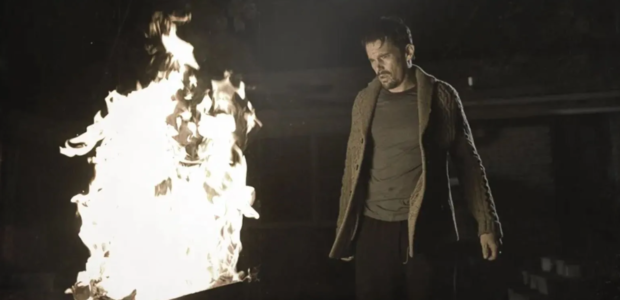
Happy Halloween, and to all a good fright! We asked our contributors,
What scary movies do you watch for comfort, not chills, especially at this time of year?
Every year, as the first hints of October whisper through the foliage and every house on the block puts out their plastic ghosts, jack-o’-lanterns, and budding chrysanthemums, I feel an overwhelming sense of nostalgia.
As a New England native, I spent my summers scampering through the towns and beaches where JAWS was filmed. I grew up with yearly autumnal school trips to Salem and spent my youth burying my face in copies of Goosebumps and Scary Stories to Tell in the Dark that I’d bought at the September Scholastic book fair.
With every autumn came the excitement of Halloween, where my parents would fill the house with witches and tall orange candles and pumpkins. They’d have AMC’s Fright Fest playing Joe Dante’s GREMLINS or John Carpenter’s HALLOWEEN. Other times, ABC Family (now Freeform) would be doing reruns of dark kid classics like Brad Silberling’s CASPER, and I’d be glued to the screen, enchanted by the melancholy melodies of James Horner’s score and Christina Ricci’s art deco mansion.
In high school (and to this day), my mom and I would stay up late together and watch horror flicks from the golden age of science fiction. We’d pop on reruns of The Twilight Zone (a favorite of my family’s), or Tales from The Dark Side, gasping at the twists written by masters like Charles Beaumont, Rod Serling, Richard Matheson, and Ray Bradbury.
Loving horror from a young age—and identifying it with home and my youth—solidified my loyalty to the genre; it became a safe space, and a place of deep comfort for me.
This sense of comfort grew as I got into high school and devoured books like Interview with the Vampire and Ghost Story. In 2012, my junior year, a Horror Literature class was offered. My English teacher handed out a syllabus bursting with classics—excerpts from Stephen King’s Danse Macabre and Pet Sematary, William Peter Blatty’s The Exorcist, and works from Edgar Allan Poe. To accompany the book list, we’d watch notable horror films.
We were encouraged to research and watch our own—which led me to my first interaction with now-iconic Art the Clown in Damien Leone’s 2011 TERRIFIER (at the time, just a gritty, exploitation-style short film on YouTube) and Tom Six’s notorious body horror flick, THE HUMAN CENTIPEDE.
Then, in October of that year, Scott Derrickson’s SINISTER hit cinemas—a defining moment in my horror education, and my life.
The trailer was horrifying, playing on nearly every channel. My teacher encouraged my class to see it and offered extra credit for those who did.
As a young, aspiring writer interested in pursuing something related to horror, I snagged my two friends, and we dashed to our local cinema on a foggy, late October night.
As we plopped into our seats and the lights went out, a family appeared on the titanic screen before us. A grainy Super 8 home video showed them dangling from an oak tree, slowly getting hanged as the title crawled across the screen. My mind was blown. Derrickson’s opening shot is daring, staggering, and, well, brilliant.
A film, featuring Ethan Hawke as has-been true crime writer Ellison Oswalt who moves into the aforementioned family’s house, quickly unravels as he discovers more reels of similar snuff, all of which feature a freakish-faced Pagan deity named Bughuul.

SINISTER’S atmosphere stands apart from any other horror film I’ve seen. Its chilling score still haunts me to this day and never fails to make the hair on the nape of my neck stand up. The most notable scores, which are now burnt into my mind, are Ulver’s Silence Teaches You How in the BBQ ‘79 footage and Boards of Canada’s Gyroscope, which serves as the unsettling backdrop as Ellison burns the snuff reels in his backyard, tearfully panicked that he and his young family may be Bughuul’s next victims. Music aside, the film’s setting—in a foggy, deadly silent suburbia packed densely with woods—offers an uncanny sense of comfort in an otherwise violent narrative.
Not only is the music of SINISTER remarkable, but Derrickson’s masterful direction, C. Robert Cargill’s chilling writing, and Hawke’s acting—accompanied by its eerie cinematography—create an otherworldly terror tale.
In one particular scene, Ellison watches the final reel. It starts with that brilliant score again, beginning with an unnerving but slightly comforting interlude, infused with an ethereal melody. The reel, shot from outside, zeroes in on an unaware family enjoying a night together on the couch. Seconds later, the score dissipates, transitioning into a muted scene of a singular camera spotlight on a battered lawnmower. It’s raining, and there’s this long stretch of agonizing nothingness, this fantastic, eerie sequence of unknowing—until you’re brutally shocked with a speaker-blaring scream and the sudden slaughter of the family under the lawnmower.

The film’s final act is a punch to the gut, a raw, biting twist that filmmakers are rarely gutsy enough to do—kill its protagonist.
Derrickson and Cargill know how to scare, and they do it with passion.
Walking out of SINISTER, I rambled to my friends. When I got home, I rambled to my parents and brother. When I got to class, I rambled to my teacher—who pointed out that through my rambling, I was analyzing the film.
And I loved it.
From then on, my view of horror changed. It was so much more than a fun genre, more than just getting scared—it was something to be educated by. My view of horror was molded and pieced together, squashed, and reshaped, into this sudden knowing: I wanted to write about horror.
SINISTER is, without a doubt, one of the terrifying films of all time, and has solidified its rightful place as a cult classic.

I realize a normal moviegoer wouldn’t find Super-8 snuff, a scruffy-looking Ethan Hawke screaming in a wool cardigan, and murderous children exactly “comforting,” but to me, SINISTER is my comfort movie—and always will be. It brings comfort in a multitude of ways. It makes me nostalgic. I love its cozy atmosphere of a rainy, foggy-ridden sleepy suburbia, and I’ll forever be grateful for its effect on me as a young, impressionable aspiring writer and horror fan.
Each Halloween season conjures a melancholic sense of nostalgia for my youth, and all horror films bring a comfort that no other genre can.
SINISTER stands out among the rest as my go-to comfort movie. It summons the memories of teenage me, sitting in the dark cinema, watching the film that would shape me into the journalist I am today.
Tags: Boards of Canada, Comfort Horror, Ethan Hawke, Horror, Scott Derrickson, Ulver



No Comments